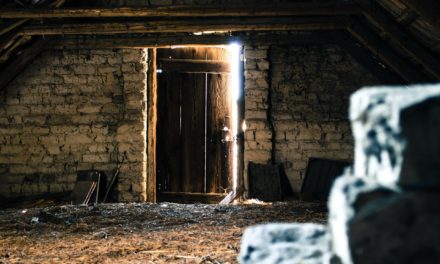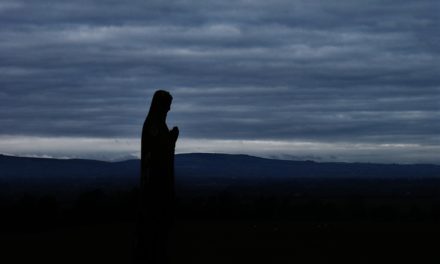Jungians call the field of awareness, or the Great Mystery, the numinous: that which is behind a cloud and therefore can’t be seen. My first experience of the numinous was when I was twenty years old. I had just emerged from a three-week stay in the hospital, recovering from the many cuts and bruises I suffered when I lost control of my scooter and rammed into a tree. My friend Heidi, our two dogs, and I were now on a trip to Italy in my little red car. I felt banged up, exhausted, and estranged from my family. In short, I was in a profound existential crisis and desperately needed some time to recover before university started up again back home in Germany.
I recall sitting in the green hills close to St. Francis of Assisi’s hermitage in Umbria. His little hut, built about eight hundred years earlier, featured irregular rock walls with tiny windows and a low, narrow door. The stone shed where St. Francis had lived and prayed was surrounded by ancient trees and fragrant flowers. The late afternoon sun left a warm glaze on everything. Fall colors were taking over as the trees and leaves turned yellow and red. I unexpectedly felt overcome by a delicious, timeless state of momentary peace. An hour and a half seemed to fly by in a second. When Heidi returned from a walk with our dogs, their soft noses snapped me back to current reality. It was as if grace had recognized my despair and given me a gift. Maybe my complete lostness had opened me to a gentle longing for something more.
Moments of grace—of opening to the numinous, to the Great Mystery—often happen in the wake of crisis. In times of great desolation, something may spontaneously crack within us. The veil that divides our mundane, everyday experience from a deeper perception of reality—what we might call universal reality—becomes thinner and more porous. Sometimes such a crack happens when we are in the utmost despair, grief, or sadness –triggering a constellation of longstanding, recurrent, painful patterns (LLRPs) –and this new opening reveals the peace and loving awareness that is primordially present.
A former client told me of a time when he tried to throw himself from a high balcony at his university during the darkest moment of a manic episode. The mirage of an angel of light appeared, showing him for just an instant the great unity of life. A short time later, when my client was jogging in the countryside, something stopped him. It was as if the presence of God were there. My client asked this presence about the purpose of his terrible experience of mania, depression, and mental hospitals. He received the answer to use his experience to help others. My client eventually became a psychiatrist, and he continues to be of assistance to many others in need. Spontaneous experiences of grace cannot be forced, but we can be open to those moments and recognize them as they happen, valuing such miraculous flashes as gifts from the universe. Even when we don’t entirely understand what it is that we have opened to, we might try out what it is like to take a “leap of faith” and allow glimpses of a wider way of experiencing reality. Doing so can transform our perspective and increase our insight, helping us to shift in our relationship with a difficult LRPP.
In my path of practice, I had to crack my head one more time before I stopped to rethink what is valuable and meaningful for me in life. Just a month after my trip to Italy, I had another accident. I drove my little red car right into a streetlight, crashing my head through the windshield. The hospital stay that followed was much longer and more serious than the first one. I remember my first night in the hospital, lying on a gurney in a long hall. Light flooded down on me and I was not quite sure whether I was alive or dead. Somehow it didn’t matter. I was in a timeless, formless state, as if suspended and at peace. Then the morning came, and I awoke in the urgent care ward. I was not happy to be cast back into “normal” reality, having to deal with the fallout from this new accident.
It is quite usual for people to suffer repeated crises before they are able to open their eyes to a larger reality. Sometimes we have to be forced to our knees before we can open up and let the light stream in. The ego, our sense of self as usual, holds on as long as it can. It is as if our heart has to be tenderized before it can let go.
After my first accident, I had worked hard to hold on to “business as usual,” trying to force myself back into old ways of doing life even though they had not been working for me in the first place. When we look at our own life, we might recognize times when we ignored the warning signs. We often feel reluctant to change our habits and our ways of doing things. We may be afraid of displeasing others or embarrassing ourselves. Or we may even disregard miracles because they don’t fit into a rational and known framework for perceiving experience.
The language of the sacred may be clear, forceful, and at times harsh, as in the examples above, but at other times, the signs of the numinous are subtle and quiet. Dreams and synchronicities can be elusive and obscure. My Native American friend Wolf Wahpepah calls such signs “breadcrumbs of the creator.” We must allow ourselves to stop in our tracks, notice, and then follow those breadcrumbs as they lead us back home.
From Heart Medicine: How to Stop Painful Patterns and Find Peace and Freedom—at Last by Radhule Weininger © 2021 by Radhule Weininger. Reprinted in arrangement with Shambhala Publications, Inc. Boulder, CO. shambhala.com







My Tarot reader reminds me of your manic-depressive patient. On her podcast she talks about having the bipolar disorder. (Burning Tarot podcast) The grace of seeing God and Nature come in this ‘illness’ to the reward of clients like me. How can grace make you suicidal, that is the question we do not understand.